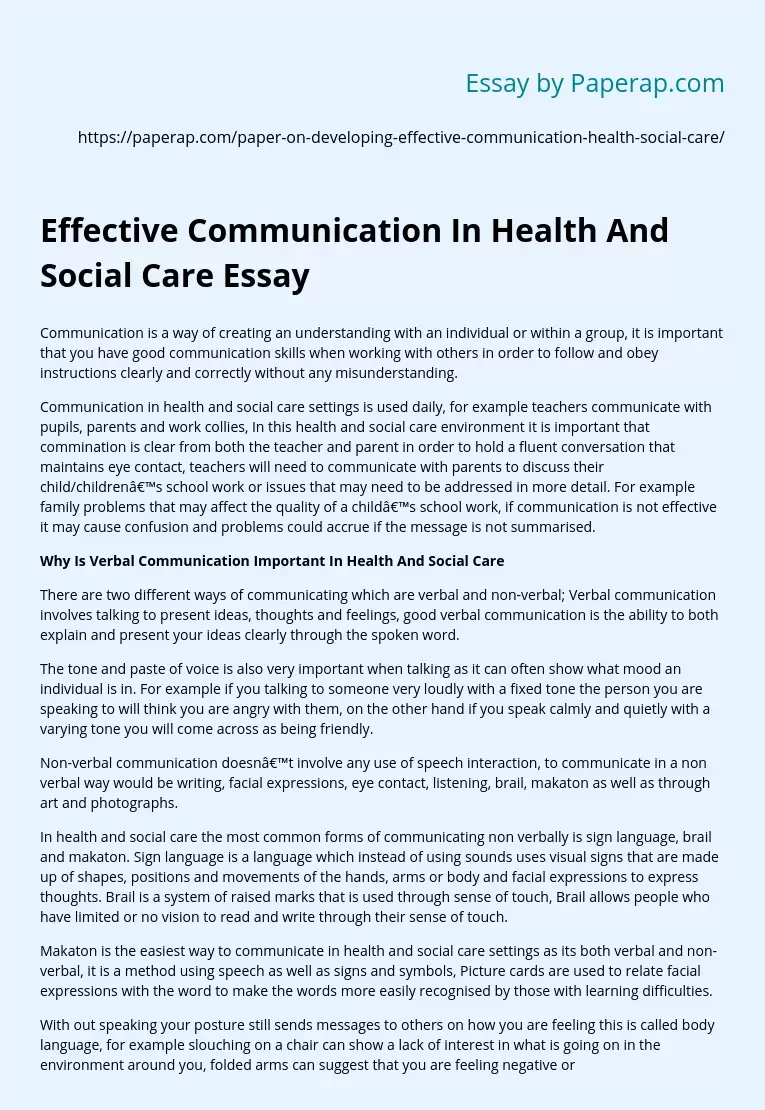Effective Communication In Health And Social Care Essay
Communication is a way of creating an understanding with an individual or within a group, it is important that you have good communication skills when working with others in order to follow and obey instructions clearly and correctly without any misunderstanding.
Communication in health and social care settings is used daily, for example teachers communicate with pupils, parents and work collies, In this health and social care environment it is important that commination is clear from both the teacher and parent in order to hold a fluent conversation that maintains eye contact, teachers will need to communicate with parents to discuss their child/children’s school work or issues that may need to be addressed in more detail.
For example family problems that may affect the quality of a child’s school work, if communication is not effective it may cause confusion and problems could accrue if the message is not summarised.
Why Is Verbal Communication Important In Health And Social Care
There are two different ways of communicating which are verbal and non-verbal; Verbal communication involves talking to present ideas, thoughts and feelings, good verbal communication is the ability to both explain and present your ideas clearly through the spoken word.
The tone and paste of voice is also very important when talking as it can often show what mood an individual is in. For example if you talking to someone very loudly with a fixed tone the person you are speaking to will think you are angry with them, on the other hand if you speak calmly and quietly with a varying tone you will come across as being friendly.
Non-verbal communication doesn’t involve any use of speech interaction, to communicate in a non verbal way would be writing, facial expressions, eye contact, listening, brail, makaton as well as through art and photographs.
In health and social care the most common forms of communicating non verbally is sign language, brail and makaton. Sign language is a language which instead of using sounds uses visual signs that are made up of shapes, positions and movements of the hands, arms or body and facial expressions to express thoughts. Brail is a system of raised marks that is used through sense of touch, Brail allows people who have limited or no vision to read and write through their sense of touch.
Makaton is the easiest way to communicate in health and social care settings as its both verbal and non-verbal, it is a method using speech as well as signs and symbols, Picture cards are used to relate facial expressions with the word to make the words more easily recognised by those with learning difficulties.
With out speaking your posture still sends messages to others on how you are feeling this is called body language, for example slouching on a chair can show a lack of interest in what is going on in the environment around you, folded arms can suggest that you are feeling negative or defensive about a person or situation, this is also known as closed body language and people may hesitate on approaching you.
How ever if you have good eye contact with the person who is talking, and nod when appropriate this shows that you are interested and that you are taking in the information that is being shared. Its very important in health and social care that you show you are listening and that you care, listening to people involves allot more than just hearing what they say, to listen effetely you need to hear the words/question being spoke, thinking what they mean, then thinking of a appropriate response, In a health and social care environment working with a individual that has learning difficulties/problems (such as speech problems) and you are not taking notice to what they are saying, the individual will get distressed and frustrated if they are not understood, which could also lead to low self esteem, this is called active listening.
There will be times when communicating with others is not going to be easy, there are a verify of reasons that could effect communication, such as language differences, learning difficulties, environment, hearing or sight impairments, and jargon, however there are many possible ways to overcome these barriers to create a better understanding.
A barrier blocks communication and stops messages from being received clearly, Language differences is a barrier as not everybody you meet throughout your life will speak the same first language as you. To overcome this you would need to use a lot of hand gestures, speak clearly, and paste your voice. Pictures could also be used to communicate. However in extreme situations the use of interpreters will make communication a lot clearer, for example in health and social care settings a patient may not understand what the doctor/nurse is trying to explain to them about their health.
Environments IS also a common barrier as it is very head to hear what someone is saying if there is a lot of distracting background noise. It is also very difficult to make sense of individual’s facial expressions if the lighting in the room is poor. Also you may become distracted if someone walks past the door or window, in health and social care settings a school is a great example as pupils will be more interested in what is out of the window rather than focusing on what the teacher is saying.
Effective Communication In Health And Social Care Essay. (2019, Dec 05). Retrieved from https://paperap.com/paper-on-developing-effective-communication-health-social-care/

